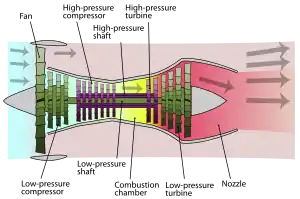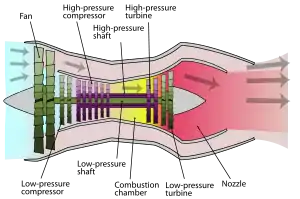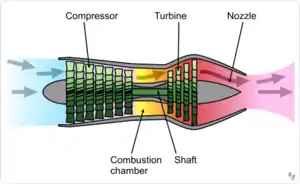نسبت کنار گذر
نسبت کنار گذر (انگلیسی: bypass ratio) یک موتور توربوفن، نسبت بین سرعت جریان جرم هوای کنار گذر از سرعت جریان جرم هوایی است که وارد هسته موتور میشود. [1] به عنوان مثال ، یک نسبت کنار گذر ۱۰: ۱ به این معنی است که ۱۰ کیلوگرم هوا به ازای هر ۱ کیلوگرم هوایی که از هسته موتور عبور میکند از مجرای کنار گذر میگذرد.



تصویر شماتیک موتورهای توربوفن
کنار گذر بالا (تصویر بالایی) دارای یک فن بزرگ است که هوای بیشتری را به کنار هسته موتور (توربین) میفرستد، موتور با کنار گذر پایین (تصویر میانی) فن کوچکتری دارد و هوای بیشتری را به توربین میرساند و موتور توربوجت (تصویر پایین) هیچ کنارگذری ندارد و تمامی هوا وارد توربین میشود.
کنار گذر مصرف سوخت کمتری را برای همان موتور به همراه دارد که به عنوان مصرف سوخت ویژه رانش (گرم / ثانیه برای هر واحد رانش در KN با استفاده از واحدهای SI ) اندازه گیری می شود. موتورهای توربوپروپ با نسبت کنار گذر زیاد مصرف سوخت کمتری نسبت به دیگر موتورها دارند که در این دسته از موتورهای جت از یک پروانه به جای فن ورودی موتور استفاده میشود. [2] [3] [4] [5]
نسبت کنار گذر چند نوع موتور
منابع
- https://www.britannica.com/technology/bypass-ratio
- Ilan Kroo and Juan Alonso. "Aircraft Design: Synthesis and Analysis, Propulsion Systems: Basic Concepts Archive" Stanford University School of Engineering, Department of Aeronautics and Astronautics. Quote: "When the bypass ratio is increased to 10-20 for very efficient low speed performance, the weight and wetted area of the fan shroud (inlet) become large, and at some point it makes sense to eliminate it altogether. The fan then becomes a propeller and the engine is called a turboprop. Turboprop engines provide efficient power from low speeds up to as high as M=0.8 with bypass ratios of 50-100."
- Prof. Z. S. Spakovszky. "11.5 Trends in thermal and propulsive efficiency Archive" MIT turbines, 2002. Thermodynamics and Propulsion
- Nag, P.K. "Basic And Applied Thermodynamics" p550. Published by Tata McGraw-Hill Education. Quote: "If the cowl is removed from the fan the result is a turboprop engine. Turbofan and turboprop engines differ mainly in their bypass ratio 5 or 6 for turbofans and as high as 100 for turboprop."
- Animated Engines
This article is issued from Wikipedia. The text is licensed under Creative Commons - Attribution - Sharealike. Additional terms may apply for the media files.